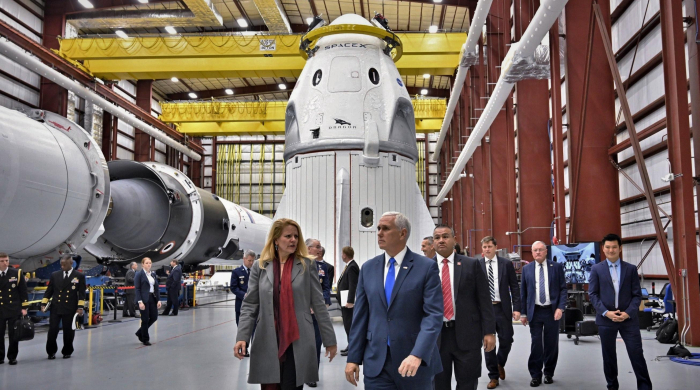Currently targeting launch no earlier than (NET) January 17th, this inaugural Crew Dragon launch – known as Demonstration Mission 1 (DM-1) – will be conducted without a crew aboard to ensure that the spacecraft’s performance and characteristics fit within design parameters, hopefully giving NASA the data it needs to certify Crew Dragon to launch astronauts as early as June 2019.
Aside from the wonderful fact that all (or nearly all) of the hardware needed for Crew Dragon’s launch debut can be seen in the four photos posted today, this is also the first time SpaceX has ever provided a real photo of the next-gen spacecraft’s trunk-based solar array. A dramatic departure from Cargo Dragon’s more traditional duo of multi-panel solar arrays, which deploy from disposable covers and fold out like wings, SpaceX decided from the start that Crew Dragon would take a much different approach. In a move that presumably cut the risk of solar array deployment, Crew Dragon’s panels are conformally attached (i.e. curved to fit) to the disposable trunk’s rear exterior.
Rather than deploying its arrays like wings, Crew Dragon will always have its solar cells ready and waiting to generate power, simply requiring the spacecraft to face one half of its trunk towards the sun. According to a few individuals involved with the trunk, guaranteeing food fitment between individual cells and subsections and avoiding the problems caused by different thermal expansion coefficients (shrinking and expanding as the temperature changes) was no easy task and led to many, many headaches in the final weeks of integration and testing. From a less objective standpoint, Crew Dragon’s new conformal solar array is absolutely stunning, and it will be a shame to see each sculpture-like trunk relegated to a destructive atmospheric reentry after each launch.
Pragmatically speaking, it’s extremely satisfying to see all the hardware (both rocket and spacecraft) effectively under the same roof at the launch pad they will soon lift off from. Much like Falcon Heavy, NASA’s Commercial Crew Program (CCP) has been beset with the better part of two years of delays from original launch targets in 2017 for both Boeing and SpaceX. Since then, a combination of NASA bureaucracy and technical/programmatic stumbles made by both companies have conspired to almost indefinitely delay the first uncrewed and crewed trips to orbit.
SpaceX suffered catastrophic Falcon 9 failures in both 2015 and 2016 and has largely been working to ameliorate the technical and organizational flaws that allowed those anomalies to occur, while also having to convince NASA that they are ready to safeguard the lives of the space agency’s astronauts. Since SpaceX’s last known total vehicle failure in September 2016, Falcon 9 and Falcon Heavy have managed an extraordinary 37 successful launches in a row in a little more than 24 months.
SpaceX is targeting Crew Dragon’s first orbital launch sometime in January 2019, with the placeholded launch date currently sitting on January 17th, pending International Space Station (ISS) availability and NASA’s go-ahead. Given the presence of Falcon 9 B1051 in 39A’s integration hangar and the fact that SpaceX technicians already appear to be integrating the first and second stages, the company may well be ready to perform a full-up dress rehearsal – involving Falcon 9 and Crew Dragon rolling out and going vertical on Pad 39A – before 2018 is out.
Teslarati.com
More about: science
















































